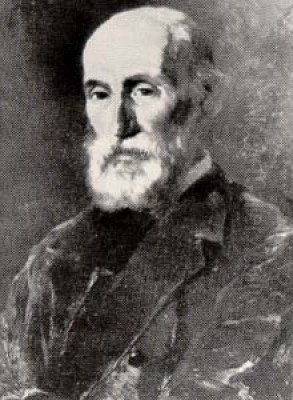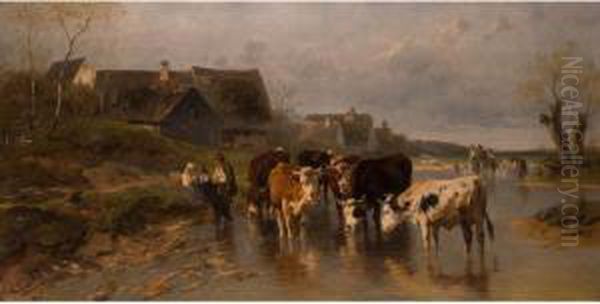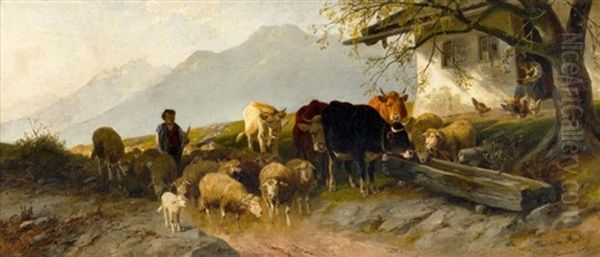
Christian Friedrich Mali stands as a significant figure in 19th-century German art, particularly associated with the Munich School of painting. Born in 1832 and passing away in 1906, his life spanned a period of considerable artistic evolution in Germany. Mali carved a distinct niche for himself primarily as a painter of landscapes and animals, capturing the essence of rural Bavaria with sensitivity and remarkable technical skill. His works remain appreciated for their detailed realism, atmospheric depth, and affectionate portrayal of pastoral scenes.
Early Life and Artistic Awakening
Christian Friedrich Mali entered the world on October 6, 1832. While some sources suggest a Dutch origin, citing Broekhuizen near Utrecht as his birthplace due to his Dutch parentage, the prevailing consensus points to his birth near Biberach an der Riß in the Kingdom of Württemberg, Germany. His artistic inclinations may have been nurtured early on, potentially under the guidance of an uncle named Peters, who might have introduced him to the meticulous traditions of Dutch landscape painting, emphasizing fine detail and the careful study of light.
A pivotal moment in Mali's artistic journey occurred in 1857 when he relocated to Munich, the burgeoning art capital of Germany at the time. The city's vibrant artistic environment, particularly the influence emanating from the Munich Academy of Fine Arts, proved formative. He absorbed the prevailing trends, likely drawing inspiration from the detailed realism and narrative focus championed by influential figures like Carl Theodor von Piloty, even if not directly studying under him. This environment encouraged a focus on technical proficiency and direct observation from nature.
Munich was also where Mali forged a crucial lifelong friendship and artistic association. In 1860, he met Anton Braith, another painter who would become renowned for his depictions of animals, particularly cattle. This meeting was profoundly influential, steering Mali more decisively towards incorporating animals, especially sheep and cattle, as central elements within his landscape compositions. Their shared artistic interests and temperaments laid the foundation for a close personal and professional bond that would last for decades.
The Munich School and Mali's Evolving Style

Christian Friedrich Mali is firmly situated within the context of the Munich School, a broad term encompassing the styles and artists associated with the city's Academy from the mid-19th century onwards. This school was characterized by its emphasis on realism, often infused with genre elements and a penchant for dramatic lighting and painterly brushwork, moving away from the stricter Neoclassicism and Nazarene movements of earlier decades.
Mali's style evolved under these influences, blending meticulous observation with a palpable sense of atmosphere. His early training, possibly rooted in Dutch traditions, instilled in him a respect for detail and craftsmanship. This is evident in the careful rendering of textures – the fleece of sheep, the bark of trees, the stonework of rural buildings. He became particularly adept at capturing the interplay of light and shadow, using it to define form, create mood, and unify his compositions.
While grounded in realism, Mali's work often retains a subtle Romantic sensibility, particularly in his treatment of landscapes. There's an appreciation for the quiet grandeur of the Bavarian Alps, the tranquility of lakeside scenes, and the gentle rhythms of rural life. He avoided overt melodrama, preferring instead to find beauty in the everyday workings of the countryside. His paintings often evoke a sense of peace and harmony between humanity, animals, and the natural world.
His association with Anton Braith further refined his focus on animal painting. While Braith concentrated more intensely on the individual character of cattle, Mali typically integrated animals, most famously sheep, seamlessly into broader landscape settings. He depicted them not just as static elements but as living parts of the environment – grazing, resting, or being herded through the picturesque Bavarian scenery.
Key Themes and Subjects
Mali's oeuvre is dominated by specific recurring themes and subjects, reflecting his deep connection to the region around Munich and the Bavarian Alps. He was fundamentally a landscape painter, but one whose landscapes were almost always animated by the presence of animals or subtle signs of human activity.
Sheep are arguably the most iconic motif in Mali's work. He painted them countless times, often in flocks, traversing mountain paths, resting by lakeshores, or being driven home at dusk. These depictions showcase his skill in rendering individual animals while also capturing the collective movement and character of the flock. Works like Schafe bei der Überfahrt am Seeufer (Sheep at the Crossing by the Lake Shore) exemplify this focus.

Cattle also feature prominently, likely influenced by his friendship with Braith. Paintings such as KÜHE AM FLUSS (Cows by the River) demonstrate his ability to portray these larger animals with convincing weight and presence within sun-dappled riverine landscapes. He captured their placid nature and their integration into the agricultural life of the region.
The Bavarian landscape itself was a constant source of inspiration. Mali depicted rolling hills, dramatic Alpine vistas, serene lakes, and rustic farmsteads. He was sensitive to the changing seasons and times of day, often favouring the warm, diffused light of late afternoon or the soft ambiance of overcast skies. His landscapes are rarely empty; they serve as the stage for the pastoral life he so admired.
Rural life and the theme of 'Heimkehr' or returning home is another common thread. Paintings titled Heimtrieb (Driving Home) or Herde Heimkehr (Flock Returning Home) capture the gentle end-of-day ritual of shepherds or herders guiding their animals back to the farm or village. These scenes often possess a quiet, contemplative mood, enhanced by his skillful use of evening light.
Representative Works
Several specific paintings stand out as representative of Christian Friedrich Mali's artistic output and recurring themes:
Schafe bei der Überfahrt am Seeufer (Sheep at the Crossing by the Lake Shore): Painted in Munich in 1895, this relatively large work (79.5 x 126 cm) is a quintessential Mali scene. It depicts a flock of sheep being guided across a narrow point near a lake, showcasing his mastery in handling numerous figures within a detailed landscape setting. The clear signature and date confirm its authenticity, despite minor condition issues noted in some records.
Herde Heimkehr (Flock Returning Home): Dated 1878, this smaller painting (32.6 x 78 cm) captures the intimate theme of animals returning home at the end of the day. Its dimensions suggest a panoramic format, suitable for depicting the movement of the flock through the landscape. Its presence in a German private collection and estimated auction value (€3000-€5000) indicate its desirability among collectors. Another work titled Heimtrieb from 1879 (32 x 74 cm) explores a similar theme and format.
KÜHE AM FLUSS (Cows by the River): Created in 1882, this substantial painting (58.5 x 116 cm) highlights Mali's skill in depicting cattle within a luminous riverside landscape. The size and subject matter, combined with its estimated value (€8000-€9000), mark it as a significant work.
Holländische Küstenlandschaft mit heimkehrender Schafherde (Dutch Coastal Landscape with Returning Flock of Sheep): The title suggests a potential nod to his Dutch heritage or perhaps a scene inspired by travels. The high auction estimate (€10,000) reflects the market's appreciation for his well-executed compositions, even those potentially set outside his usual Bavarian milieu.
Liegendes Schaf (Lying Sheep): This earlier work from 1871 (39.5 x 50 cm) likely represents a detailed study of an individual animal, showcasing his observational skills and ability to capture the texture of fleece and the relaxed posture of the sheep. Its modest estimate (€1000-€1200) reflects its nature as perhaps a study or smaller piece.
Berglandschaft bei Biberach (Mountain Landscape near Biberach): Dated 1906, the year of his death, this small work (20.5 x 31.5 cm) connects him directly to the town that would become central to his legacy. The specific numbering ("M2995") might relate to his estate inventory.
These examples illustrate the consistency of Mali's themes – sheep, cattle, landscapes, the rhythm of rural life – and his technical proficiency in oil painting across various scales and formats throughout his career.
The Enduring Partnership with Anton Braith
The friendship between Christian Mali and Anton Braith (1836-1906) was one of the defining relationships of Mali's life and career. Meeting in Munich in 1860, they quickly found common ground in their artistic pursuits and shared Swabian origins (Braith was also from Biberach). Their bond deepened over the years, leading them to eventually share an artist's studio and household, first in Munich and later establishing strong ties to Biberach.
Their artistic interests complemented each other. While both excelled at animal painting, Braith became particularly famous for his powerful, often dramatic depictions of cattle, sometimes in challenging situations like crossing rivers or caught in storms. Mali, while equally skilled with animals, tended to place them more harmoniously within broader, often more tranquil, landscape settings, with sheep being his signature subject. It's widely acknowledged that Braith's focus on animal anatomy and behaviour significantly influenced Mali's own development in this area.
They remained lifelong companions, unmarried, and dedicated to their art. Their shared studio became a repository of their works, studies, and collected objects. This close association extended beyond their lifetimes, as both artists decided to leave their substantial artistic estates to their hometown of Biberach an der Riß.
Life and Legacy in Biberach an der Riß
Although much of his professional career was based in Munich, Christian Mali, along with Anton Braith, maintained strong connections to Biberach an der Riß. This connection was solidified posthumously through their generous bequests to the town. Both artists died in 1906, Braith in March and Mali in October.
Their wills stipulated that their artistic estates – comprising hundreds of paintings, thousands of drawings and sketches, personal belongings, studio furnishings, and even works by other artists they had collected – should go to Biberach. Mali's estate alone included an impressive inventory: 270 oil paintings, 716 drawings, 48 prints, 226 works by other artists, and over 1000 items described as 'salon interior pieces'. Braith's legacy was similarly substantial, including 670 oil paintings, numerous sketchbooks, and a significant sum of money (20,000 Goldmarks).
Fulfilling their wishes, the town of Biberach established the Braith-Mali-Museum, officially opening shortly after their deaths. The museum was initially housed in the historic 'Hospital zum Heiligen Geist', a medieval building complex. It aimed to preserve and display the artists' studios and works, offering a unique insight into the lives and creative processes of two successful Munich School painters. Mali had even requested the erection of a "Braith-Mali monument" in the hospital courtyard, further cementing their joint legacy.
The museum, still active today (though potentially relocated or expanded over time), stands as a testament to their artistic achievements and their affection for their Swabian roots. It preserves not only their paintings but also the ambiance of their 19th-century artist studios, making it a significant cultural institution in the region.
Artistic Context and Contemporaries
Christian Friedrich Mali worked during a vibrant period in German art history. The latter half of the 19th century saw the consolidation of the Munich School's influence, the lingering impact of Romanticism, the rise of Realism, and the beginnings of Impressionist tendencies filtering in from France. Mali navigated these currents, largely adhering to a detailed, atmospheric realism rooted in close observation of nature.
His work can be contextualized alongside several key contemporaries:
Anton Braith (1836-1906): His closest associate, renowned for cattle painting, sharing studio space and a legacy in Biberach.
Carl Theodor von Piloty (1826-1886): A leading figure at the Munich Academy, known for historical realism, whose emphasis on technique likely influenced the environment Mali entered.
Eduard Schleich the Elder (1812-1874): A prominent Munich landscape painter known for his atmospheric depictions of the Bavarian plains, often compared to Dutch masters, potentially influencing Mali's handling of light and mood.
Adolf Lier (1826-1882): Another important Munich landscapist, influenced by the French Barbizon School, known for his intimate landscapes and focus on mood, particularly evening scenes, which resonates with some of Mali's work.
Joseph Wenglein (1845-1919): A later Munich painter specializing in landscapes of the Isar river valley and Upper Bavaria, continuing the tradition of detailed yet atmospheric realism.
Caspar David Friedrich (1774-1840): Though from an earlier generation, the legacy of this preeminent German Romantic landscape painter, with his emphasis on nature's spiritual and sublime qualities, formed part of the background against which later artists like Mali worked. Friedrich's meticulous technique might also be seen as a precursor.
Johann Christian Dahl (1788-1857): A Norwegian painter closely associated with German Romanticism (and Friedrich), known for his dynamic landscapes capturing specific light and weather conditions.
Ludwig Richter (1803-1884): Primarily associated with Dresden, Richter's idyllic, often narrative-infused landscapes and illustrations represented another facet of German Romanticism focused on harmonious depictions of nature and simple life.
Wilhelm Marck and Emil Neumann: Mentioned as contemporaries within the broader Romantic landscape tradition, contributing to the rich tapestry of German nature painting in the 19th century.
Carl Hilgers (1818-1890): A Düsseldorf School painter known for his winter landscapes, representing a different but parallel stream of German landscape painting focused on realism.
French Barbizon School Painters: Artists like Constant Troyon (1810-1865) (also an animal painter), Jules Dupré (1811-1889), and Charles-François Daubigny (1817-1878) were influential across Europe for their direct painting from nature and atmospheric realism. Mali visited Paris and likely absorbed influences from such movements.
Mali's position within this landscape was that of a dedicated practitioner of realistic landscape and animal painting, deeply rooted in the Munich tradition but retaining a personal, often gentle and idyllic vision of the Bavarian countryside.
Enduring Appeal and Conclusion
Christian Friedrich Mali's contribution to German art lies in his consistent and skillful depiction of the landscapes and rural life of Bavaria. He captured a world that was beginning to change with industrialization, preserving idyllic scenes of pastoral harmony with meticulous care and sensitivity. His focus on sheep, rendered with remarkable detail and integrated seamlessly into atmospheric settings, became his hallmark.
His close association with Anton Braith and their joint legacy in the Braith-Mali-Museum in Biberach provide a unique narrative of artistic friendship and regional loyalty. The museum ensures that their works and lives remain accessible, offering a window into the world of 19th-century Munich School painters.
Today, Mali's paintings are appreciated for their technical accomplishment, their tranquil beauty, and their evocative portrayal of nature. They continue to find favour among collectors, as indicated by respectable auction estimates. While perhaps not as revolutionary as some of his contemporaries, Christian Friedrich Mali remains a significant and well-regarded artist who expertly chronicled the light, land, and life of 19th-century Bavaria, leaving behind a legacy of peaceful and enduring images.